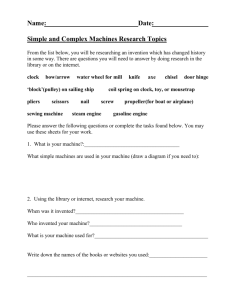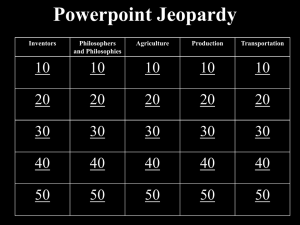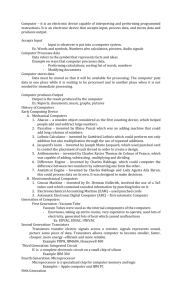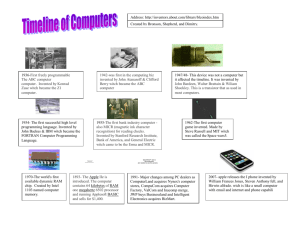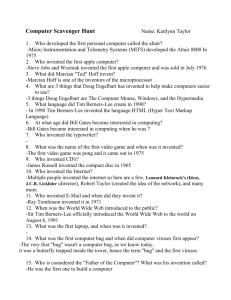Prof. Dr. N. Prabhudev Vice-Chancellor BANGALORE UNIVERSITY
advertisement
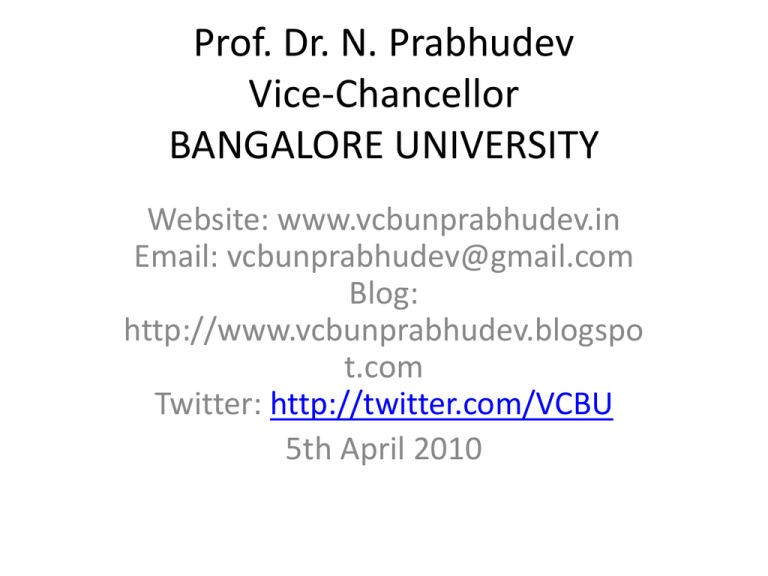
Prof. Dr. N. Prabhudev Vice-Chancellor BANGALORE UNIVERSITY Website: www.vcbunprabhudev.in Email: vcbunprabhudev@gmail.com Blog: http://www.vcbunprabhudev.blogspo t.com Twitter: http://twitter.com/VCBU 5th April 2010 Achievements of Ancient Indian Civilization Indian invented the number 0 (Zero) India invented the Number System. Zero was invented by Aryabhatta India was the richest country on earth till the British invasion in the 17th century. India has never invaded any country in her last 10,000 year history. Aryabhata (500 AD) took the earth to spin on its axis and he described the planet periods with reference to the sun. He also took the solar system to be several hundred million miles across. In all of these things he was ahead of the rest of the world by more than a thousand years. Bhaskara (12th century) was a brilliant mathematician. Bhaskaracharya calculated the time taken by the earth to orbit the sun hundreds of years before the astronomer Smart. Time taken by earth to orbit the sun: (5th century) 365.258756484 days. The value of pi was first calculated by Budhayana and he explained the concept of what is known as the Pythagorean Theorem. He discovered this in the 6th century long before the European mathematicians. Algebra, Trigonometry and Calculus came from India; Quadratic equations were by Sridharacharya in the 11th century; Father of Wireless communication was Prof. Jagdeesh Bose and not Marconi. Chess (Shataranj or Ashtapada) was invented in India. French scholar Romain Rolland said: If there is one place on the face of the earth where all the dreams of living men have found a home from the very earliest days when man began the dream of existence, it is India. India will soon be home to the world’s tallest building, World Centre of Vedic Learning which is 700 feet taller than Petronas Towers in Kuala Lumpur as depicted in the picture above. It will also have many times larger mass than any existing tall buildings. The site of the building is at the centre point of India, Northeast of Jabalpur. Indians discovered ZERO. Hindu- Arabic Numerals are ours. Trigonometry, Algebra are our resources. Indian Mythology says WORLD IS ROUND.. NOT FLAT Science in its broadest sense, any systematic knowledge-base or prescriptive practice that is capable of resulting in a correct prediction, or reliably-predictable type of outcome. In this sense, science may refer to a highly skilled technique, technology, or practice, from which a good deal of randomness in outcome has been removed. Science is a continuing effort to discover and increase human knowledge and understanding through disciplined research. Using controlled methods, scientists collect observable evidence of natural or social phenomena, record measurable data relating to the observations, and analyze this information to construct theoretical explanations of how things work The ability of the general population to understand the basic concepts related to science is referred to as scientific literacy Philosophy of science It is universally agreed that scientific hypotheses and theories must be capable of being independently tested and verified by other scientists in order to become accepted by the scientific community Atmospheric science Atmospheric science is a broad term used to describe the study of a planet's atmosphere, its chemical and physical processes, the effects other systems have on it, and the atmosphere's effects on these other systems. Atmospheric science is generally broken up into three sub sciences: Meteorology, Climatology, and Aeronomy. The Earth's atmosphere, a layered sphere of gas extending upward more than 600 km from the surface, forms the environment for terrestrial life. The different layers: the troposphere, where weather occurs; the stratosphere, where a blanket of protective ozone lies; the mesosphere, the home of beautiful noctilucent clouds (also know as polar mesospheric clouds or PMC's); and the thermosphere, host to the colorful aurora (northern/southern lights SPACE PHYSICS Matter can be found in four different states. There are three that we are very familiar with: solid, liquid, and gas. The fourth state, plasma, is much more unfamiliar to us. The field of space physics deals with the study of solar system plasmas (gases of charged particles). Plasmas fill much of the known cosmos, and the interactions of such charged gases determine the behavior of matter within our solar-terrestrial system. But the spatial, temporal, and density scales we can explore in space are much different from those produced in earthbound laboratories Therefore, our solar-terrestrial system - which is composed of dynamic and complex systems of moving particles, magnetic fields, and electrical currents - serves as a nearby example of what probably happens throughout our whole universe. It is a unique laboratory for investigating the natural processes that occur in nearly all astrophysics and it is a laboratory that we can reach relatively easily with rockets and spacecraft. Studies of the different space environments of planetary objects test our understanding of the underlying physical principles occurring under different situations to that found at Earth. As our appreciation of the Sun-Earth system has grown more sophisticated, so too has our technology. Today, a tangled web of electrical and communication links has been woven across Earth's surface By using electromagnetic techniques to enhance communication, navigation, reconnaissance, and weather prediction that generally make the world safer, we have also put ourselves in danger. Every tool and gadget that relies on radio waves, conducting wires, and sensitive transistors and processing chips can be affected by disturbances in the solarterrestrial system. Fraction of solar radiation that is transmitted to the Earth’s surface over a spectral region accounting for approximately 95% of the total energy from the Sun. The term "scientific misconduct" refers to situations such as where researchers have intentionally misrepresented their published data or have purposely given credit for a discovery to the wrong person Criticism of science Many issues damage the relationship of science to the media and the use of science and scientific arguments by politicians. As a very broad generalisation, many politicians seek certainties and facts whilst scientists typically offer probabilities and caveats. However, politicians' ability to be heard in the mass media frequently distorts the scientific understanding by the public. The tradition of science and technology (S&T) in India is over 5,000 years old. A renaissance was witnessed in the first half of the 20th century. The S&T infrastructure has grown up from about Rs. 10 million at the time of independence in 1947 to Rs. 30 billion. Significant achievements have been made in the areas of nuclear and space science, electronics and defence. The government is committed to making S&T an integral part of the socio-economic development of the country. To me, India represents the spirit of excellence and pursuit of beauty and truth in art and science. There is nothing parochial about this idea; it is inspiring, and it helps us find our common ground with all humanity. Our schools must celebrate this spirit and remembering great masters is a part of the process. Making peace with the past will make it easier to move on with the business of creating a great future for everyone
